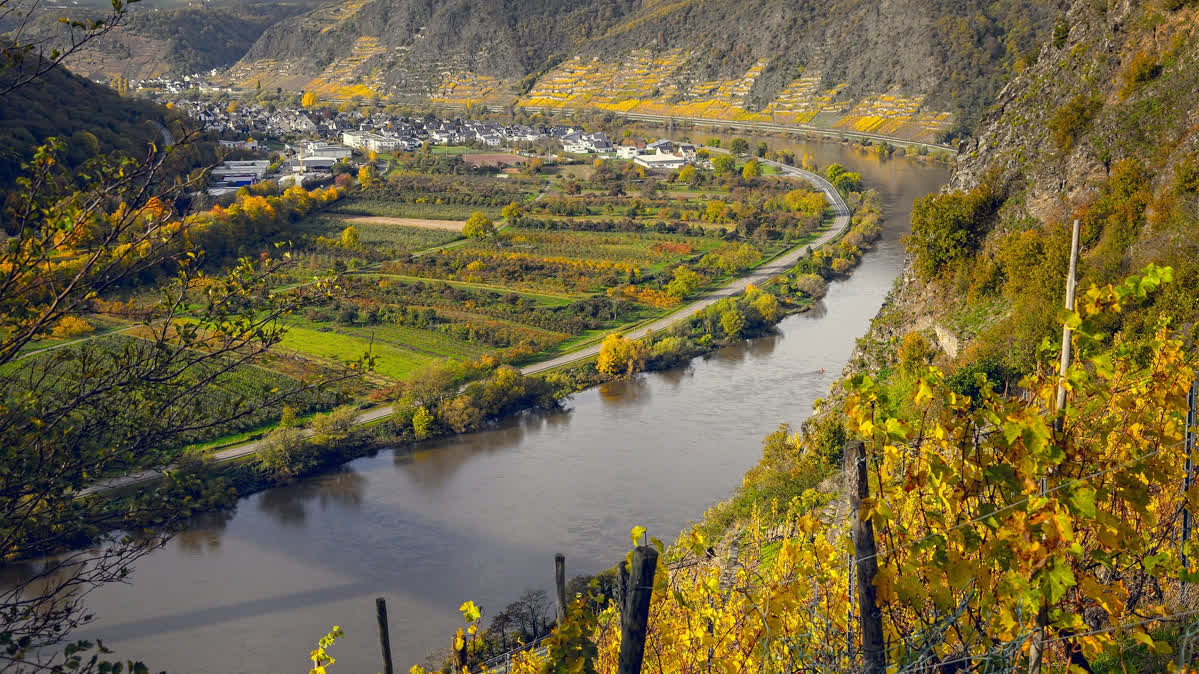
Karl May Blutsbruder Rot Bio 2020 is a medium-bodied, dry red wine with complex aromas of blackberry, sloe, and green pepper.
German red wines offer an impressive variety and outstanding quality.























German red wines enjoy an excellent reputation worldwide. Their diversity and quality have greatly increased in recent decades. With different climate zones and soil types, German wine regions offer ideal conditions for growing red wine grapes. In this article, we will highlight the unique characteristics of German red wines, their key growing regions, and the most popular grape varieties.
German red wines are characterized by their elegance and complexity. They are often fruity and have a good acid structure, which makes them particularly well-suited for aging. Most German red wines have a medium to full body and a deep red color. Typical aromas include red and dark berries, cherries, and plums, accompanied by spicy notes like cinnamon and cloves.
Due to the cooler climatic conditions, the wines develop a lively acidity that gives them freshness. This freshness is a hallmark of many German red wines. Aging often takes place in oak barrels, which adds additional complexity and depth to the wines.
Germany has 13 official wine-growing regions. Each region has its own characteristics and conditions that give the wines their unique notes. The most important regions for red wine are:
Baden is the southernmost wine-growing region in Germany and is known for its Burgundy wines. The climate here is warm and sunny, providing ideal conditions for grape varieties like Spätburgunder (Pinot Noir), Schwarzriesling (Pinot Meunier), and Lemberger. The wines from Baden are full-bodied, fruity, and often of high quality.
The Pfalz is one of the largest wine regions in Germany. With a mild climate and a long growing season, the conditions for red wine cultivation are ideal. Dornfelder, in particular, has established itself here. The wines are powerful, dark, and often have a pronounced fruit note. Spätburgunder and Portugieser are also found in the Pfalz.
The Ahr Valley is one of the smallest wine regions in Germany, but it is famous for its red wines. Spätburgunder dominates here. The steep slopes and slate soil give the wines a special minerality. Ahr wines are elegant, fine, and have a good structure.
Rheinhessen is the largest wine-growing region in Germany. In addition to white wines, red wines are increasingly being cultivated here. Dornfelder, Spätburgunder, and Portugieser are the most important varieties. The wines are fruity, soft, and often uncomplicated.
Germany offers a variety of red wine varieties. Here are the most popular grapes:
Spätburgunder is the most important and widely planted red wine variety in Germany. The grape is demanding and requires optimal conditions to reach its full potential. The wines are elegant, complex, and have fine tannins. Typical aromas are cherry, strawberry, and raspberry, often accompanied by light spice notes.
Dornfelder is a relatively young variety that was bred in the 1950s. It has quickly made a name for itself and is particularly popular in the Pfalz and Rheinhessen. The wines are deep red, fruity, and have a good structure. Dornfelder is often more robust than Spätburgunder and is well-suited for aging in barrique.
Lemberger, also known as Blaufränkisch, originally comes from Austria but has found a home in Germany, especially in Baden and Württemberg. The wines are powerful, spicy, and have a good tannin structure. Typical aromas include dark berries, plums, and spices.
Portugieser is an old grape variety that presumably originates from present-day Portugal. The wines are light, fruity, and uncomplicated. They are excellent as a summer wine or as a companion to light dishes. The main growing regions are Rheinhessen and the Pfalz.
German red wines are versatile and match many occasions and dishes. A light Spätburgunder is excellent as an aperitif or with light appetizers such as salads or fish dishes. The elegant aromas and fine acid structure harmonize well with delicate dishes.
Heavier red wines like Dornfelder or Lemberger pair fantastically with hearty dishes. A Dornfelder complements a hearty beef filet or a game platter perfectly. The robust aromas and good tannin structure harmonize with the intense flavor of the meat.
Portugieser is ideal for sociable evenings with friends. The light, fruity wines are uncomplicated and suitable for many occasions. Whether for a barbecue evening or with a cheese platter, Portugieser is a versatile companion.
German red wines have secured a firm place in the international wine world in recent years. The diversity of growing regions and grape varieties offers a suitable wine for every taste. Whether elegant Spätburgunder, robust Dornfelder, or spicy Lemberger, German winemakers know how to bring out the best in their grapes.
Due to the cooler climatic conditions and various soil types, the wines develop a unique freshness and complexity. They are versatile and pair well with many occasions and dishes. The future for German red wines looks promising, and it remains exciting to see how the wines will continue to develop.